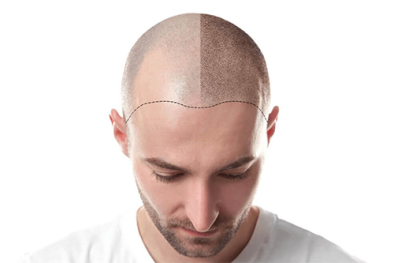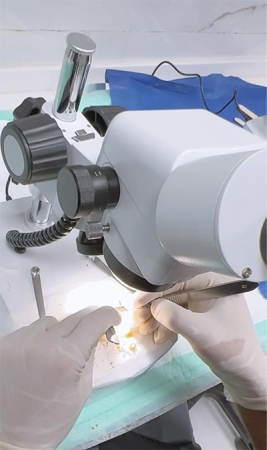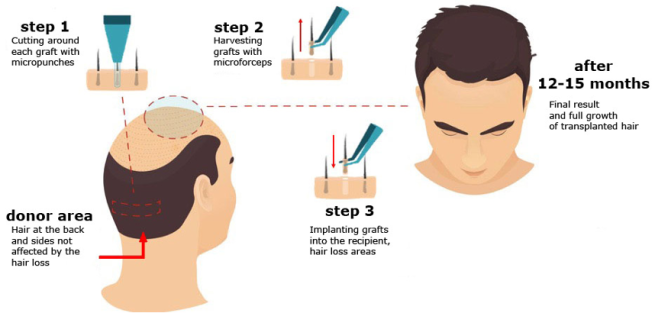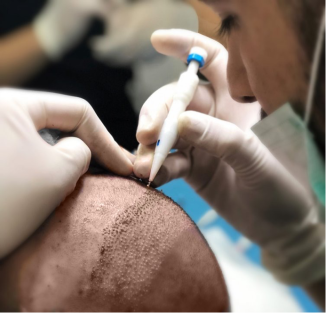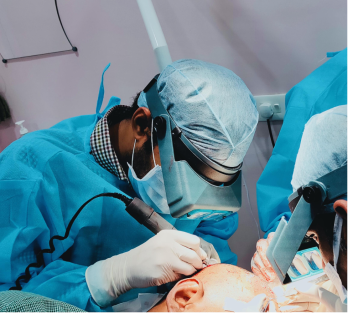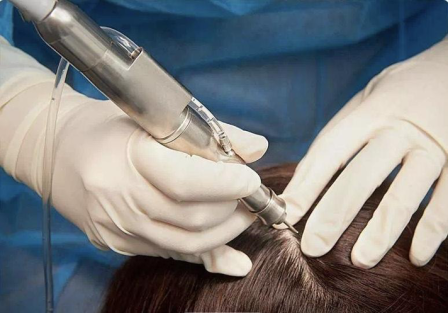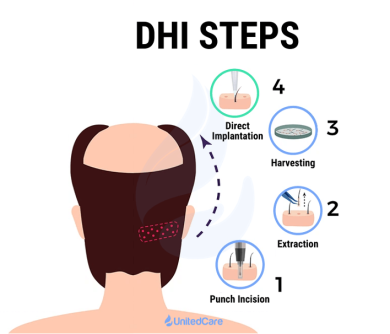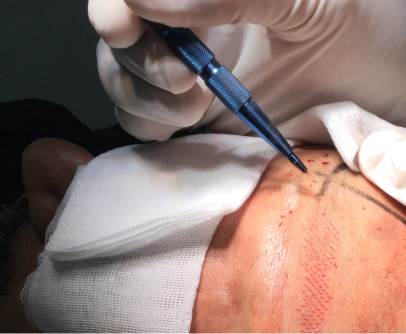ریزش مو از مشکلات شایعی است که بسیاری از افراد حتی در سنین پایین دچار آن میشوند و برخلاف باور عموم ریزش مو مختص آقایان نیست و خانم ها نیز ممکن است درجاتی از ریزش مو و نازک شدن موها را تجربه کنند. البته ریزش روزانه حدوداً ۱۰۰ تار مو طبیعی است.
علت ریزش مو می تواند ژنتیک، رژیم غذایی، استرس، بیماری ها، تغییرات هورمونی یا مصرف برخی داروها باشد.
افرادی که درگیر ریزش مو می شوند و با درمان های پزشکی مانند مصرف دارو به نتایج دلخواه خود نرسند، در چنین شرایطی، راه حل های دائمی مانند کاشت مو که نتایج طبیعی و موفق آمیزی را به همراه دارد، به کار می آید.
کاشت مو، راه حلى دائمی | کاشت مو پاسداران
کاشت مو نوعى روش جراحی است که با برداشت فولیکول ها از ناحیه بانک مو و پیوند آن ها به ناحیه گیرنده همراه است؛ منظور از ناحیه بانک مو، قسمت های پشت و کناره های سر است که تراکم موی خوبی دارند و موهای این نواحی نسبت به ریزش و تغییرات هورمونی مقاوم هستند و منظور از ناحیه گیرنده، ناحیه خالی از مو یا کم مو است. نکته بسیار مهم در خصوص کاشت مو این است که افرادی که خواهان انجام این روش هستند، باید بانک موی مناسبی داشته باشند تا نتایج ایده آل و طبیعی حاصل شود.
کاشت مو روشی جراحى است که با کمترین میزان تهاجم، نتایج شگفت انگیزی را به همراه دارد. معمولاً ۳-۴ هفته بعد از کاشت مو، شاهد ریزش موهای کاشته شده هستیم، اما بعد از گذشت ۳-۴ ماه، موها مجدد رشد کرده و نتایج نهایی ۹-۱۲ ماه بعد از جراحی، قابل مشاهده خواهد بود.
درخواست مشاوره تخصصی رایگان
هزینه کاشت مو
یکی از عوامل مهم در تصمیمگیری برای انجام کاشت مو، بررسی هزینههای مربوطه است. هزینه کاشت مو بسته به تکنیک مورد استفاده و تعداد واحدهای مو متفاوت است. برای اطلاعات دقیقتر، مشاوره رایگان با متخصصان ما میتواند به شفافسازی هزینهها کمک کند.
مراقبتهای بعد از کاشت مو
برای دستیابی به بهترین نتایج، مراقبتهای پس از عمل بسیار حیاتی است. رعایت نکات بهداشتی و دستورات پزشک از جمله مواردی هستند که باعث تسریع روند بهبودی میشوند. نکات زیر از جمله مواردی هستند که باید در مراقبتهای بعد از کاشت مو مد نظر قرار گیرند:
- استفاده از داروهای تجویزی و رعایت دوز مصرفی
- اجتناب از فعالیتهای شدید و ورزشهای سنگین در روزهای اول
- رعایت بهداشت شخصی و شستشوی مناسب موهای کاشت شده
- مشاوره منظم با پزشک معالج
عوارض کاشت مو
هرچند کاشت مو یک روش نسبتاً ایمن محسوب میشود، اما مانند هر عمل جراحی، ممکن است عوارضی نیز به همراه داشته باشد. از جمله عوارض کاشت مو میتوان به عفونت، ترشح مایعات، یا کاهش موقتی رشد مو اشاره کرد. پیگیری دقیق مراقبتهای پس از عمل و مراجعه به پزشک در صورت بروز علائم غیرطبیعی، از اهمیت ویژهای برخوردار است.
بهترین میوه بعد از کاشت مو
تغذیه مناسب نقش مهمی در روند بهبود و رشد مجدد مو دارد. مصرف میوههایی که سرشار از ویتامینها و مواد معدنی هستند، به تسریع بهبودی کمک میکند. برخی از بهترین میوه بعد از کاشت مو شامل:
- کیوی: سرشار از ویتامین C و آنتیاکسیدانها
- انگور: دارای ترکیبات مفید برای تغذیه مو
- توت فرنگی: غنی از ویتامینهای مورد نیاز برای رشد مو
در کنار این میوهها، رعایت یک رژیم غذایی متعادل به همراه مصرف پروتئینهای کافی و آب، از نکات ضروری تغذیهای میباشد.
چه چیزهایی بعد از کاشت مو ضرر دارد
برای دستیابی به نتایج مطلوب، باید از مصرف و انجام برخی فعالیتها در دوره بهبودی خودداری کرد. از جمله مواردی که بعد از کاشت مو ضرر دارد عبارتند از:
- استفاده از محصولات شیمیایی قوی یا حرارتدهی مستقیم به مو
- فعالیتهای ورزشی سنگین یا هر نوع ضربه به سر
- مصرف الکل و دخانیات که میتوانند روند بهبودی را مختل کنند
با رعایت این موارد و پیروی از دستورالعملهای پزشک، میتوانید از بروز مشکلات جلوگیری کرده و روند بهبودی را تسریع کنید.
برای کسب اطلاعات بیشتر و دریافت مشاوره تخصصی، همین امروز با شماره ما (۰۲۱۷۹۵۲۷) تماس بگیرید.
بهترین روش های کاشت مو
خوشبختانه امروزه روش های مختلفی برای انجام کاشت مو وجود دارد و پزشک متخصص با توجه به بررسی ها و معایناتی که در جلسات مشاوره انجام می دهد، به این نتیجه می رسد که کدام روش با توجه به شرایط شما مناسب تر است و نتایج زیبایی و ایده آل تری را به همراه دارد. در ادامه مطلب به ارائه روش ها مى پردازیم.
کاشت مو به روش FUT
در این روش، برشی نواری شکلی از قسمت پشت سر برداشته می شود تا امکان برداشت فولیکول ها فراهم شده و سپس این ناحیه بخیه می شود. در مرحله بعد، فولیکول ها زیر میکروسکوپ و با دقت بسیار بالا برداشته می شوند تا در قسمت های خالی سر یا همان ناحیه گیرنده، کاشته شوند. در پایان، سر پانسمان می شود تا از هر دو ناحیه دهنده و گیرنده در طول سپری شدن دوره نقاهت محافظت شود. بخیه ها در محل برش نواری در پشت سر می توانند با تشکیل زخم و اسکار همراه باشند که البته توسط موهای باقی مانده پوشانده می شود و روش های درمانی متعددی برای از بین بردن این خط موجود است.
در گذشته، FUT تنها روش کاشت مو بود و با این که این روزها روش های جدیدتری مورد استفاده قرار می گیرند، اما همچنان FUT به عنوان یکی از مؤثرترین روش های کاشت مو شناخته می شود.
کاشت مو به روش FIT یا FUE
کاشت مو به روش FIT یا FUE، به معنای برداشت فولیکول ها به صورت واحد و جداگانه است. بدین ترتیب که ابتدا هر واحد فولیکول با استفاده از ابزار مخصوصی به نام پانچ از ناحیه اهدایی/دهنده برداشته می شود، سپس داخل محلول خاصى نگهداری شده تا آماده پیوند شود. در مرحله بعد، ناحیه گیرنده بی حس و هر واحد فولیکول از طریق سوراخ های ریز ایجاد شده، کاشته خواهد شد. تعداد فولیکول های برداشت شده به میزان تراکم مو در ناحیه اهدایی بستگی دارد که در هر فردی متفاوت خواهد بود. این روش کاشت به طور متوسط، ۵-۷ ساعت به طول می انجامد.
کاشت مو به روش SUT
کاشت مو به روش SUT مشابه با روش FIT است، با این تفاوت که فولیکول ها با استفاده از ابزارهای جدید و اتوماتیک برداشته می شوند و از آن جایی که نتایج طبیعی را به همراه دارد، به تعداد افرادی که خواهان انجام کاشت مو با این روش هستند، روز به روز افزوده می شود. این تکنیک به قدری پیشرفته است که می توان گفت اغلب معایب روش های قبلی را برطرف کرده است. لازم به ذکر است که هزینه کاشت مو به روش SUT به مراتب بیشتر از هزینه روش های FIT و FUT است.
کاشت مو به روش میکروگرافت
در کاشت مو به روش میکروگرافت فولیکول ها با استفاده از هولدرهای مخصوص و الکتریکی برداشته می شوند، به همین خاطر از میزان خطای انسانی کاسته می شود؛ به علاوه این که هیچ گونه جای زخم و اسکار باقی نمی ماند و مراحل جراحی نیز با سرعت بیشتری انجام می شود.
کاشت مو به روش میکروگرافت از دقیقترین روشهای کاشت است که در آن انواع گرافتهای ۱ تا ۵ تار مویی را میتوان بدون دردسر و بافتهای اضافه پوستی خارج کرد. در این روش از میکروموتورهای کاملاً اتوماتیکی استفاده میشود که سری آنها قابل تنظیم است؛ در نتیجه میتوان انواع مختلفی از گرافتها را خارج کرد تا نتایج کاشت مو کاملاً طبیعی باشد.
کاشت مو به روش Micro FIT
در کاشت مو به روش Micro FIT از دستگاه های بسیار دقیق و ظریف و بر پایه روش FIT استفاده می شود، بدین معنا که فولیکول ها به صورت واحد و مجزا از ناحیه بانک مو برداشته می شوند. مراحل این روش نیز شامل برداشت فولیکول، آماده سازی و پیوند در ناحیه گیرنده می باشد و تنها تفاوت آن نسبت به روش های قبلی، در ابزارهایی است که در طول جراحی مورد استفاده قرار می گیرند. در این روش از ایمپلنترهای مینیاتوری استفاده می شود که می تواند سوراخ هایی را با اندازه های بسیار کوچک با قطر ۰.۶ تا ۰.۹ میلیمتر ایجاد کند؛ به این ترتیب امکان برداشت گرافتهای تک یا دو تار مویی هم وجود دارد، به علاوه این که دیگر نیازی به استفاده از ابزار جراحی برای استخراج فولیکول ها نیست.
کاشت مو به روش ترکیبی
در این روش کاشت، ترکیبی از روش های FIT و FUT استفاده می شود و در واقع، افرادی که بانک موی خوبی دارند و میزان خالی بودن سر در ناحیه گیرنده پایین است، می توانند از مزایای این روش کاشت بهره مند شوند، آن هم به این دلیل که میزان تراکم موهای کاشته شده در این روش بسیار بالا خواهد بود. در تکنیک کاشت ترکیبی، برداشت نواری اصل کار است و بخش زیادی از گرافتها را تأمین میکند؛ اما برای افزایش تراکم و بهبود نتایج از روش FUT هم استفاده میشود.
کاشت مو به روش سوپر ترکیبی
کاشت مو به روش سوپر ترکیبی امکان برداشت مو به صورت همزمان با استفاده از دو تکنیک FUT و BHT را برای آن دسته از افرادی که ریزش موی وسیعی دارند، فراهم کرده است. تفاوت روش سوپر ترکیبی با روش ترکیبی، در ناحیه اهدایی/دهنده است به گونه ای که در در روش سوپر ترکیبی از موهای بدن مانند قفسه سینه و زیر ریش استفاده می شود.
کاشت مو به روش BHT
کاشت مو به روش BHT از روشهای مخصوص آقایان است که امکان کاشت از موهای ریش، سینه و کمر را فراهم میکند. تکنیک برداشت گرافتها در این روش شبیه به کاشت مو به روش FUE است؛ ناحیه اهدای آن علاوه بر پشت سر و اطراف آن در قسمتهای دیگر بدن فرد نیز قرار دارد. به دلیل تفاوتهای ساختاری موهای بدن و موهای سر، نمیتوان این گرافتها را به عنوان گرافتهای اصلی کاشت استفاده کرد؛ اما به منظور بهبود تراکم و نتایج میتوان آنها را نیز به کار برد.
کاشت مو به روش Super FUE
کاشت مو به روش Super FUE در واقع همان FUE است که با استفاده از دستگاههای کاملاً اتوماتیک و هوشمند انجام میشود. در این روش از تجهیزات متعددی برای اطلاع از ساختار و نوع موهای فرد استفاده میشود و آنالیزهای دقیقی از وضعیت پوست سر او انجام میگیرد. این کار باعث میشود که پزشک با توجه به عمق قرارگیری موها، ضخامت آنها، نوع پوست کف سر، میزان چربی و خشکی پوست و وضعیت خونرسانی، دستگاهها را تنظیم کند تا هم تعداد دقیق گرافتها تعیین شود و هم آسیب بسیار کمتری به فولیکولهای استخراجی برسد.
کاشت مو به روش DHI
کاشت مو به روش DHI به معنای کاشت مو مستقیم است که بر پایه روش FIT یا FUE انجام می شود، به این صورت که همزمان با برداشت هر واحد فولیکول از ناحیه اهدایی، حفره هایی در ناحیه گیرنده ایجاد می شود و فولیکول ها پیوند زده خواهند شد. افراد مبتلا به آلوپسی آندروژنیک و آقایانی که ریزش مو با الگوی مردانه دارند، بهترین گزینه برای انجام کاشت مو به این روش هستند.
کاشت مو به روش Sapphire FUE
کاشت مو به روش Sapphire FUE یکی دیگر از روشهای جدید کاشت است که در آن از ابزارهای پیشرفته برای برداشت فولیکولها استفاده میشود. تفاوت اصلی Sapphire FUE با دیگر روشهای کاشت تنها در مرحله برداشت نیست و در مرحله قرار دادن گرافتها در ناحیه گیرنده نیز متفاوت است. در این روش از یک تیغه یاقوتی بسیار ریز برای خارج کردن و کاشتن فولیکولها استفاده میشود. این تیغه به پوست سر هیچ آسیبی وارد نمیکند و البته از گرافتها نیز محافظت خواهد کرد. دقت بالای تیغه در زمان برداشت باعث میشود که حجم کمتری از بافتهای اضافه همراه با گرافتها بیرون بیایند؛ در نتیجه احتمال رشد آنها بالاتر میرود.
کاشت مو به روش نئو گرافت
در کاشت به روش نئو گرافت از یک ربات مخصوص به نام ARTAS استفاده میشود که از طریق دوربین مخصوص محل دقیق برداشت گرافتها و کاشت آنها را تعیین خواهد کرد. کل فرایند استخراج و کاشت در این روش به صورت کاملاً اتوماتیک توسط خود ربات انجام میشود و پزشک تنها بر روی عملکرد آن نظارت خواهد کرد تا مطمئن شود که خطایی پیش نمیآید. البته در حال حاضر این روشها در ایران استفاده نمیشوند.

چه افرادی کاندید مناسب کاشت مو هستند؟
آقایانی (خانمهایى) که به دلیل الگوی طاسی مردانه، دچار ریزش مو شدهاند که بیش از ۵ سال ادامه داشته و سایر روشهای درمانی مؤثر واقع نشده اند.
آقایانی (خانمهایى) که انتظارات منطقی و واقع بینانهای از نتایج کاشت مو/ ابرو دارند و میدانند که ممکن است بعد از کاشت هم احتمال ریزش مو وجود داشته باشد، حتی در مواقعی که داروهایی به منظور پیشگیری از ریزش مو از سوی پزشک تجویز شده است. بسیاری افراد، حتی بعد از کاشت هم به مصرف داروها ادامه میدهند تا جلوی ریزش موی احتمالی گرفته شود، البته بهتر است این کار زیر نظر پزشک متخصص باشد.
آقایانی که چندین سال است که از ریزش مو رنج میبرند، الگوی طاسی سر در آنها ثابت باقی مانده و خواهان رفع طاسی سر خود بوده و میخواهند ظاهر جوان تری داشته باشند.
خانمها و آقایانی که به دلیل تروما، آسیب و سوختگی دچار ریزش مو شدهاند.
خانمها و آقایانی که به دلیل انجام روشهای زیبایی مانند لیفت صورت، ابرو و … با ریزش مو روبرو شدهاند.
عوامل مؤثر بر کاندید مناسب کاشت مو
سن کاشت مو: اگرچه هیچ محدودیت سنی برای کاشت مو وجود ندارد ولى باید فرد به بلوغ فکری رسیده و انتظارات منطقی از روش جراحی داشته باشد.
شرایط سلامتی: سلامت کامل بدنی و سیستم ایمنی سالم بر نتیجه کاشت مؤثر است؛ براى به حداقل رساندن احتمال بروز عوارض بعد از کاشت، باید از درمان هرگونه شرایط پزشکی و بیمارى ها اطمینان حاصل شود؛ پس اگر مبتلا به دیابت هستید یا دارویی مصرف میکنید که میتواند بر نتایج کاشت تأثیر بگذارد، حتماً با پزشک خود جهت درمان مشورت کنید.
سبک زندگی: انتخاب سبک زندگی سالم مانند رژیم غذایی متعادل و مناسب، ورزش و دوری از استرس در نتیجه کاشت مؤثر هستند؛ پس توصیه میشود از مصرف مشروبات الکلی و استعمال دخانیات تا حد امکان اجتناب شود.
نکاتی که باید قبل از کاشت مو در نظر گرفته شوند چیست؟
فرد باید انتظارات منطقی و واقع بینانهای از نتایج کاشت مو/ ابرو داشته باشد؛ به عنوان مثال، این مورد باید در نظر گرفته شود که اگر موی سر فرد کم است، بعد از کاشت نباید انتظار موی پرپشت داشته باشد و افرادی که موهای ضخیم تری دارند، نتایج بهتری خواهند داشت.
کاشت موهای ضخیم و خاکستری یا روشن، نسبت به موهای نازک و تیره، نتایج بهتری خواهند داشت.
ممکن است ۹ ماه یا بیشتر زمان ببرد تا مو در ناحیه کاشت شده رشد کند.
هزینه کاشت مو/ ابرو باید در نظر گرفته شود. کاشت مو به عنوان یک روش زیبایى در نظر گرفته شده و شامل هزینههای بیمه نخواهد شد.
احتمال بروز عوارض بعد از کاشت در افراد سیگاری بیشتر است. اگر قصد انجام کاشت مو/ ابرو را دارید، باید از چند هفته قبل، استعمال سیگار و دخانیات را کنار بگذارید.
در برخی موارد ممکن است مصرف داروهایی که به قطع ریزش مو کمک میکنند، بعد از کاشت نیز ادامه داشته باشند.
توصیه می شود افراد تا زمان متوقف نشدن روند ریزش مو، داروهایی مانند ماینوکسیدیل و فیناستراید را زیر نظر پزشک متخصص مصرف کنند تا روند ریزش تا حدی ثابت شود و بعد از آن تصمیم به انجام کاشت بگیرند.

